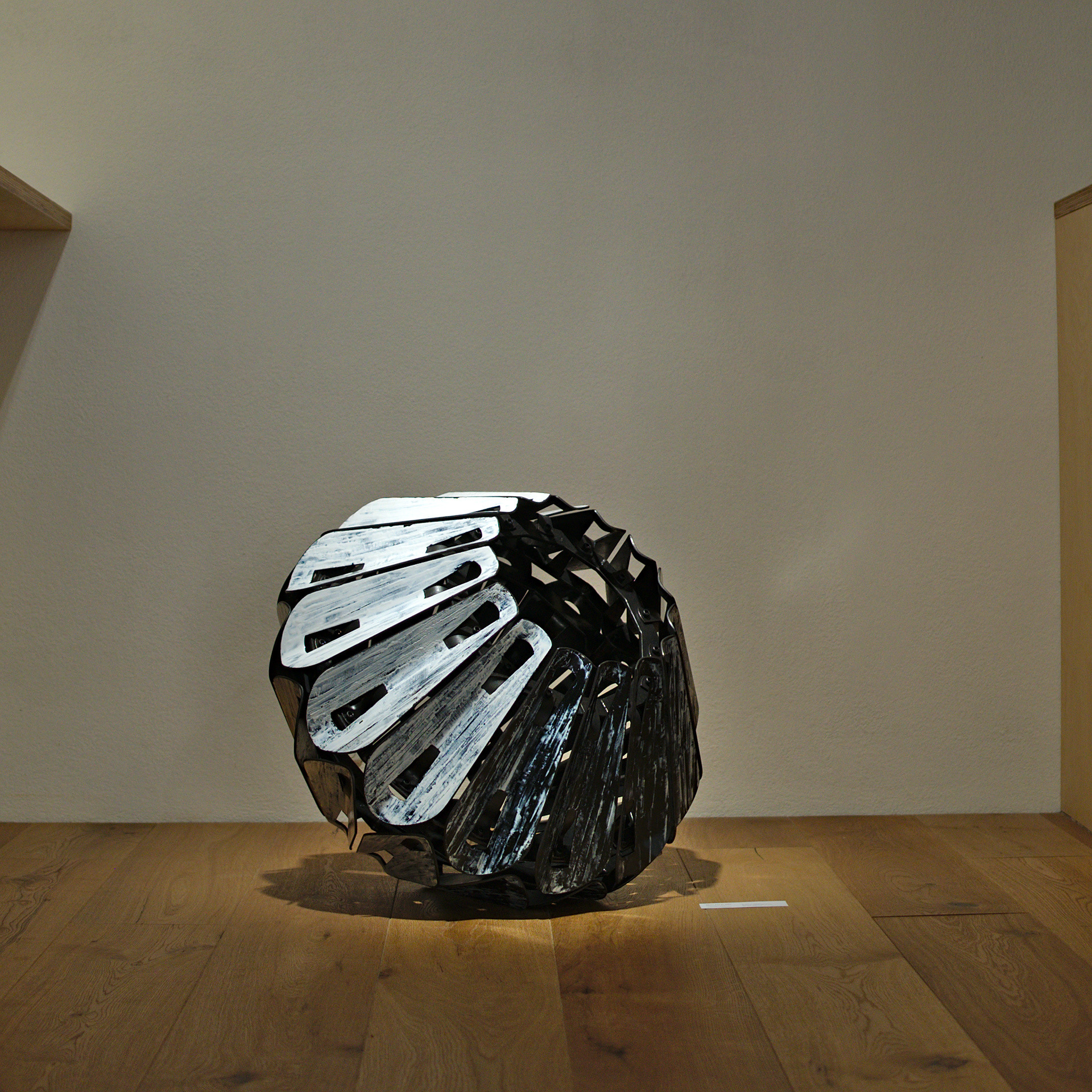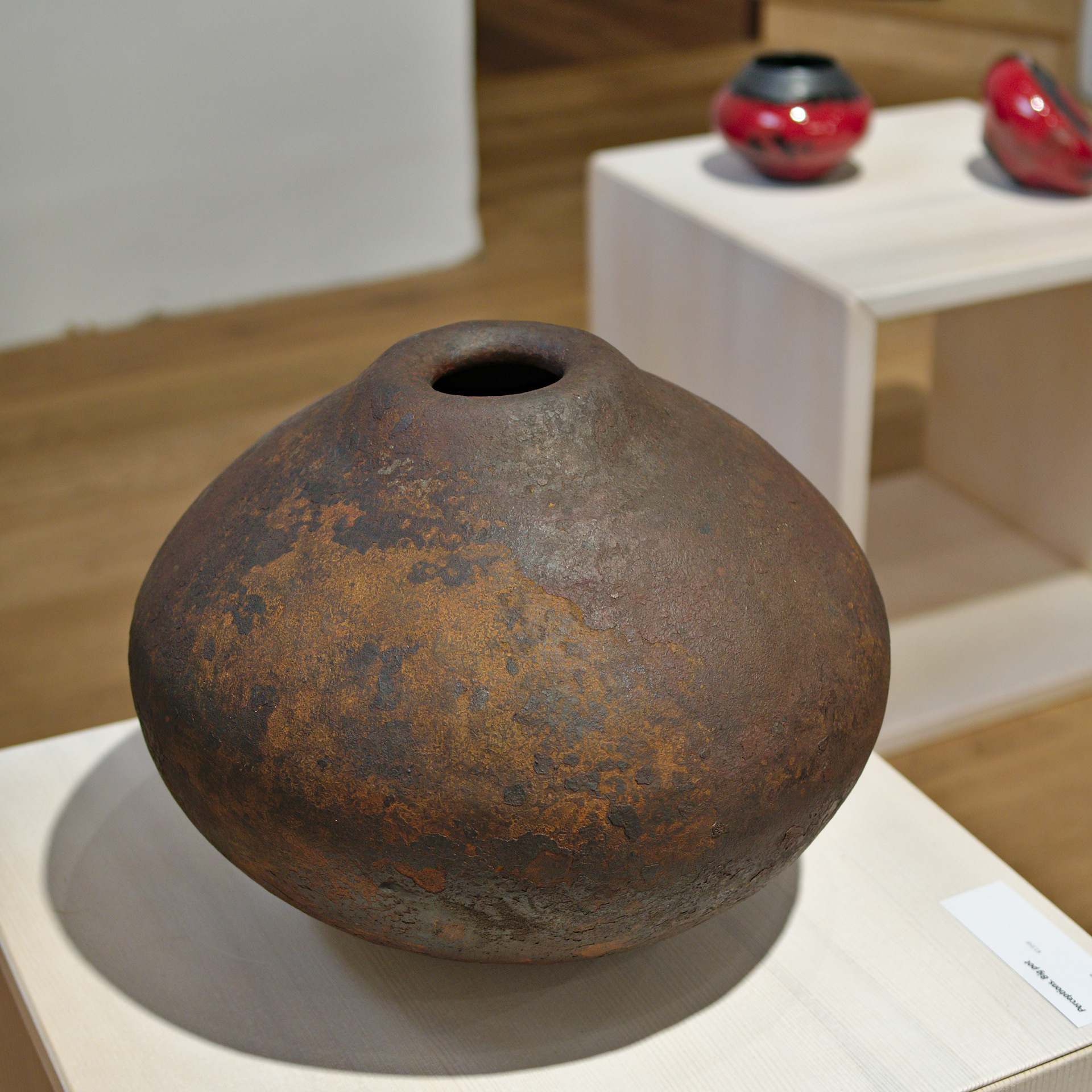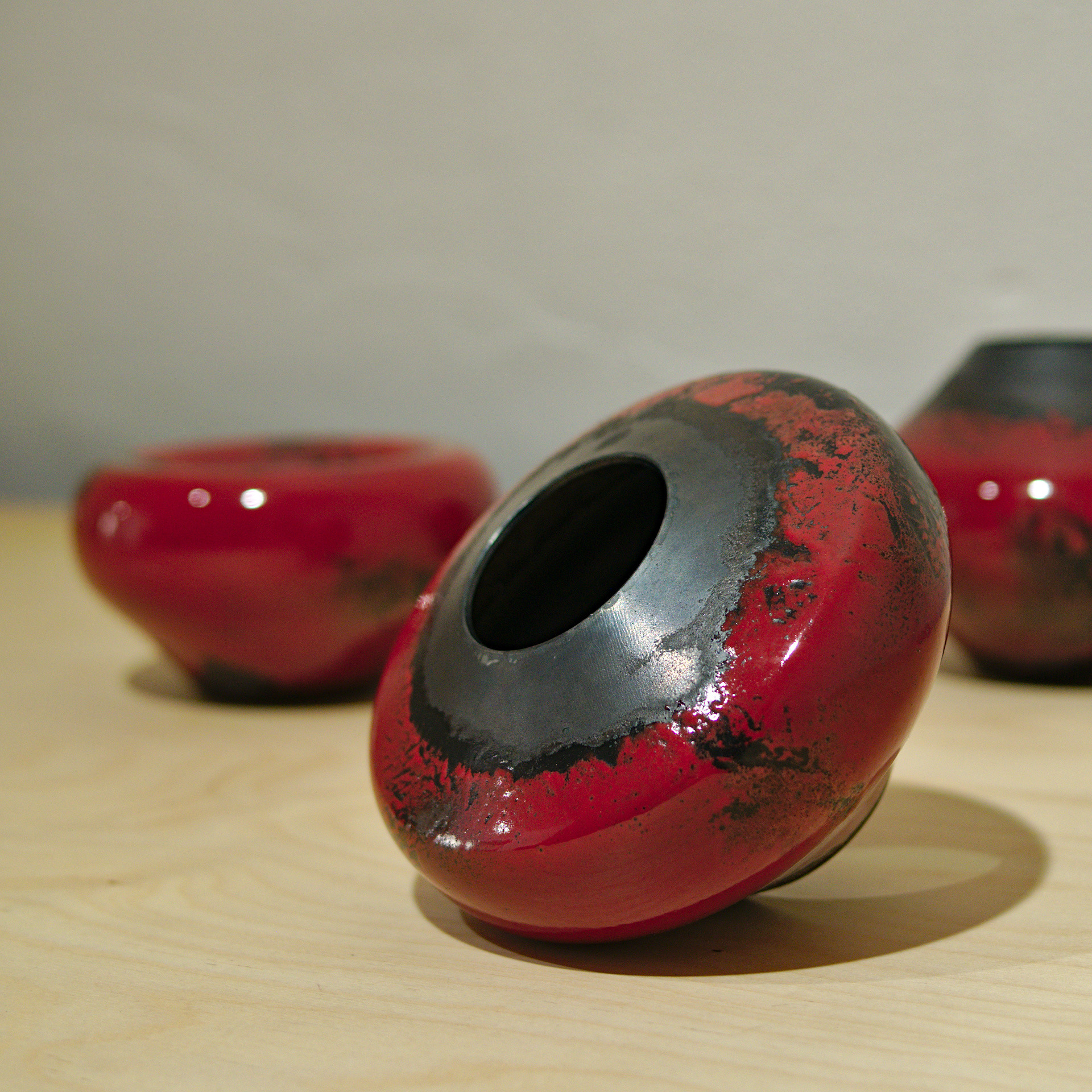„Bodenlose Frechheit“ & „Tranquil Bowl“
All Photographs by Johannes Postlmayr
Entering Galerie Hofmarcher

„Ignoramus Alpha“, Johannes Postlmayr

„Mors est in olla“, Johannes Postlmayr

„Mors est in olla“, Johannes Postlmayr

„Trainquil bowls“, Daniel Freyne

„Perceptions. Couple & Medium Pot“, Daniel Freyne

„Perceptions. Big Pot“, Daniel Freyne
Interview / Conversation
with Johannes Postlmayr & Daniel Freyne for Exhibition KONTRANYM Metal Art Objects at Galerie für Gegenwartskunst Hofmarcher in Scheibbs, Austria
A full video will follow soon and will be shared here.
[introduction, galerist]
Dear Johannes and Daniel, I am glad to have you as exhibitors in the Galerie für Gegenwartskunst Hofmarcher in Scheibbs. We are here in a region that had a centuries long history and tradition in blacksmithing and metal forming: the Eisenwurzen or iron trail between the Erzberg (ore mountain) and the Donau river. The first exhibition in this gallery had forged metal objects – so-called Metallplastiken – from about 20 international blacksmiths, each with a special connection to Schmiedezentrum Ybbsitz, where I come from. Now in this 7th exhibition we come to fresh contemporarily designed metal art objects of two individual artists from different origins with similar backgrounds having very recently studied together at a renowned school for metal artists. Shortly we will understand more...
Thank you both for bringing and exposing your precious operas!
Thank you Johannes for coming personally, and thank you Daniel for being present on air.
Now let us bring your work closer to the interested audience by formulating and answering some questions…
[starting interview / warming up]
What is your favourite tool?
jP: I guess every tool, that I make myself is somehow my favourite – but if I have to choose one it would be my carbide scriber with a titanium handle, a very simple pen thing to mark and scratch lines onto metals
dF: I would say my favourite tool would be the forge. A simple tool, however, it’s absolutely crucial within my practice. The versatility that comes with practice and experience, from my raw organic surface textures to the cracks and fissures that occur during the process of the traditional technique, fire-welding.
What influences your work recently?
jP: my latest project was in big parts influenced by historical research, but also by the latest technology
dF: A huge influence of mine would be to go against the traditional values of my Craft, to push the boundaries of what the viewer believes possible with the material iron.
What were you reading, listening to, or watching, while doing your degree in Metal Art at HDK Goteborg in Sweden?
jP: —
dF: Johannes’s sweet tender voices as he screams at me from the other side of the workshop. Reading Glenn Adamson “Thinking through craft”.
What is your fascination with metal and hot iron?
jP: the unlimited possibilities, the immense variety of material qualities
dF: I was mesmerised from the fist hammer strike, the vulnerability of iron when heated drew me to pursue a career as a Blacksmith. I was always intrigued, that with the right skills the iron can be manipulated like clay.
Exhibition title. What was your intention in choosing the title Kontranym for your co-exhibition?
jP: Referring to the linguistic term for a single word that has multiple, different meanings. So it’s basically about the similarities and the differences between us and our work.
We both received a quite traditional training as blacksmiths at a young age but in different parts of Europe. We met in Sweden to study Metal Art, and both our practice now is around objects and vessels, but still going different ways.
dF: There was always a red thread between Johannes and I’s work, we always worked within the same frame work, making vessels and objects. However, what was not similar, was the work itself. Having been trained in a similar fashion then studied the same course, what we found fascinating was that difference. Thus, wanting to call the exhibition Kontranym, the same but different.
[digging deeper]
Cutting edge education. HDK Metal Art at Goteborg Sweden and Artist Blacksmithing Hereford England/Wales or Metalsmithing at Carbondale Illinois compete as the hottest academic opportunities to study metal art and metal forming. What has let you decide for the first?
jP: For me, I think it was never a question of either-or because since I found out about it like 4 years ago, I knew it was the right thing. The major points are the well-equipped facilities, the freedom and approach of Scandinavian art education, and everything condensed into this small but very international place in the Swedish countryside.
dF: I chose to study at HDK Metal Art because of the freedom it allowed me to have, having already been trained as a Blacksmith, I wanted to start working on my own artist intentions.
What is the aftertaste now, shortly after finishing your degree? What thoughts or feelings remain from experiencing this kind of studies? How did you experience the modes of studying and teaching at this school, that is cutting edge for the world of metal design?
jP: It was three great years, but unfortunately ended with this pandemic situation, that, of course, changed how things work there and affected our exam period - but I hope they find a good way to make it work again with this new situation.
dF: —
Not expected. Name 1 or 2 things or discoveries, you did not expect from these studies.
jP: Personally, I thought I will do way more hot forging during my studies, but in the end I hardly stood at the anvil at all.
dF: In all fairness, I did not think I would be only making vessels at the end of my three years! I don’t mean that in a negative aspect though, the freedom that has come from it is amazing. I see the vessel as my canvas, and my paint is the three-dimensional surface texture.
Traditional blacksmithing. What have you taken from your previous education in traditional blacksmithing? How did it shape your style of working and creating? How did that form your attitude to contemporary design?
jP: I guess it’s the problem-solving attitude, like if the standard way doesn’t work you naturally just come up with a one of a kind solution, like making a special tool or jig or something. Another thing is paying attention to the small details, without losing sight of the whole, and vice versa.
dF: As previously mentioned, I love to challenge the traditional values of the Craft of blacksmithing. However, I truly believe that without the exposure that I had to the timeless craft, that would not be possible. By trying to progress the Craft, my work falls into the category of Contemporary Craft, or applied Arts.
What makes the difference? What makes the difference between traditional style and contemporary mode of designing and forming metal?
jP: Difficult question. First of all, everyone should do that what brings him joy. If your thing is traditional style blacksmithing and you love it, that’s great. I think it gets problematic when someone states it as the only true and right thing, like “this is the only way how to do it because we are doing it like this since always”. But that’s a classic conservative thing I guess, this fear of innovation, and found everywhere.
dF: It is really difficult to answer... But, we can say: in traditional there is right and wrong, in contemporary it always just has to be different.
[coming to an end]
What is on your horizon? What is your next step or stage in your artistic creation or professional life?
jP: Hard to say in these uncertain times, but continuing with the enamelled vessel objects would be great, but I also look forward to different projects on my own, as well as with great people.
dF: It’s all up in the air right now with the current COVID situation, but as it stands, I will be enrolling into the Masters Programme at HDK. I want to dedicate the next two year to creating more sires of work.
Whose work is currently on your radar?
jP: Daniel Freyne. Jokes aside, you scroll through Instagram and see so much good stuff all the time, but to name some of our age in other fields I would say, in ceramics Luke Fuller, in jewellery Eve Balashova and Lotta Snijder, and in photography Ness Rubey.
dF: Tom Joyce, #thenewmakers, #craftmagazine
[ende]

„Bodenlose Frechheit“, Johannes Postlmayr
Johannes Postlmayr und Daniel Freyne begannen ihre Reise auf ähnliche Weise, obwohl sie in verschiedenen Gegenden Europas eine Ausbildung als traditionelle Schmiede genossen. Diese Auseinandersetzung mit dem zeitlosen Handwerk war die Grundlage für ihre progressive Herangehensweise an ihre Arbeit mit Metall, die später während ihres gemeinsamen Studiums „Metal Art“ an der HDK Steneby an der Universität Göteborg, Schweden, verfeinert wurde.
Diese Ausstellung repräsentiert das grenzenlose Potenzial zeitgenössischer Metallkunst ― wie sich dieselbe traditionelle Fertigkeit in zwei verschiedene künstlerische Ausdrucksformen entwickelte.
Diese Ausstellung repräsentiert das grenzenlose Potenzial zeitgenössischer Metallkunst ― wie sich dieselbe traditionelle Fertigkeit in zwei verschiedene künstlerische Ausdrucksformen entwickelte.
„Perceptions. Small Pots“, Daniel Freyne
Johannes Postlmayr and Daniel Freyne started their journey in a similar fashion, although from opposite sides of Europe, they both received training as traditional blacksmiths. This exposure to the timeless craft was the foundations for their progressive approach to working with metal, later honed while they studied ‘Metal Art’ together at HDK Steneby, at the University of Gothenburg, Sweden.
This exhibition represents the limitless potential of contemporary metal work, how the same traditional skill set, evolved into two different artistic expressions.
This exhibition represents the limitless potential of contemporary metal work, how the same traditional skill set, evolved into two different artistic expressions.
„Milk Packs“, Johannes Postlmayr
Pushing the limitations of his material, Daniel Freyne (born in Scotland) is an artist with the creative drive to excel in his craft and produce intriguing metal work of the highest quality. Having been trained as a blacksmith, Daniel received an in-depth knowledge about iron, particularly in the context of forge work.
His experimental process seeks new methodologies for working, and in this process, he has found a creative liberation. This liberation has allowed Daniel to capture the imagination of his audience through consistently producing quality forge work that defies expectations. Through Daniel’s work, he aims to demonstrate the limitless potential of contemporary craft by changing the viewer’s perspective of ‘what’ a blacksmith is.
His experimental process seeks new methodologies for working, and in this process, he has found a creative liberation. This liberation has allowed Daniel to capture the imagination of his audience through consistently producing quality forge work that defies expectations. Through Daniel’s work, he aims to demonstrate the limitless potential of contemporary craft by changing the viewer’s perspective of ‘what’ a blacksmith is.
Referring to himself as a metal-gestalter, Johannes Postlmayr (born in Upper Austria) wants to bridge the labels maker, designer and artist. By using this terminology, he is also avoiding the possible restriction to a specific set of techniques that the term blacksmith might do.
Coming from the blacksmithing craft, as well as being influenced by minimalistic design and engineering. Johannes combines these elements in his work with spontaneous and coincidental features.
This contrast of precision and improvisation, of specially made tools on one side, and allowing forms to collapse under pressure on the other side, distinguishes Johannes work from the last two years. Seen as well in the opposition in his enamelwork, where defined steel objects are partially coated with vitreous enamel, randomly structured by contamination or manipulation with the help of gravity.
Coming from the blacksmithing craft, as well as being influenced by minimalistic design and engineering. Johannes combines these elements in his work with spontaneous and coincidental features.
This contrast of precision and improvisation, of specially made tools on one side, and allowing forms to collapse under pressure on the other side, distinguishes Johannes work from the last two years. Seen as well in the opposition in his enamelwork, where defined steel objects are partially coated with vitreous enamel, randomly structured by contamination or manipulation with the help of gravity.
